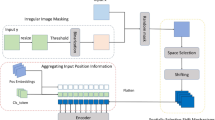Abstract
Random erasing uses rectangular areas to erase images, which improves model generalization performance, but there is too much loss of original image information. In this paper, we introduce a novel approach, the improved data augmentation method based on random walk algorithm, called random walk-based erasing (RWE), for training the CNN model. Compared with random erasing, RWE has more information about the original image because it uses scatter points to erase the original image instead of rectangular boxes. We execute experiments related to random erasure and deploy them on existing models, aiming to explore factors that benefit model accuracy. Firstly, we execute a test to determine parameter setting and validate compatibility. Then, the results of our methods on image classification and object detection tasks were obtained. Finally, we compare the impacts that random erasing and RWE make on image classification and object detection tasks, respectively. The results of different tasks indicate that our methods increase the accuracy by \(\sim \)2.00% on CIFAR-100 and map by \(\sim \)0.5% on the VOC-2007 dataset.



Similar content being viewed by others
Explore related subjects
Discover the latest articles and news from researchers in related subjects, suggested using machine learning.Availability of data and materials
The datasets generated during and/or analyzed during the current study are available from the corresponding author on reasonable request.
References
Zhong, Z., Zheng, L., Kang, G., Li, S., Yang, Y.: Random erasing data augmentation. In: Proceedings of the AAAI Conference on Artificial Intelligence, vol. 34, pp. 13001–13008 (2020)
Fonseca, J., Bacao, F.: Research trends and applications of data augmentation algorithms. arXiv preprint arXiv:2207.08817 (2022)
Simonyan, K., Zisserman, A.: Very deep convolutional networks for large-scale image recognition. arXiv preprint arXiv:1409.1556 (2014)
Krizhevsky, A., Sutskever, I., Hinton, G.E.: Imagenet classification with deep convolutional neural networks. Commun. ACM 60(6), 84–90 (2017)
Srivastava, N., Hinton, G., Krizhevsky, A., Sutskever, I., Salakhutdinov, R.: Dropout: a simple way to prevent neural networks from overfitting. J. Mach. Learn. Res. 15(1), 1929–1958 (2014)
Ioffe, S., Szegedy, C.: Batch normalization: accelerating deep network training by reducing internal covariate shift. In: International Conference on Machine Learning, pp. 448–456 (2015)
Van Dyk, D.A., Meng, X.-L.: The art of data augmentation. J. Comput. Graphical Stat. 10(1), 1–50 (2001)
Deng, X., Zhao, H., Zhang, H., Zhang, J., Mei, B.: Grid self-occlusion: a grid self-occlusion data augmentation for better classification. Signal Image Video Process., pp. 1–9 (2022)
Ribeiro, B., Towsley, D.: Estimating and sampling graphs with multidimensional random walks. In: Proceedings of the 10th ACM SIGCOMM conference on Internet measurement, pp. 390–403 (2010)
Deng, J., Dong, W., Socher, R., Li, L.-J., Li, K., Fei-Fei, L.: Imagenet: a large-scale hierarchical image database. In: 2009 IEEE Conference on Computer Vision and Pattern Recognition, pp. 248–255. IEEE (2009)
Hinton, G.E., Srivastava, N., Krizhevsky, A., Sutskever, I., Salakhutdinov, R.R.: Improving neural networks by preventing co-adaptation of feature detectors. arXiv preprint arXiv:1207.0580 (2012)
Tompson, J., Goroshin, R., Jain, A., LeCun, Y., Bregler, C.: Efficient object localization using convolutional networks. In: Proceedings of the IEEE Conference on Computer Vision and Pattern Recognition, pp. 648–656 (2015)
Park, S., Park, J., Shin, S.-J., Moon, I.-C.: Adversarial dropout for supervised and semi-supervised learning. In: Proceedings of the AAAI Conference on Artificial Intelligence, AAAI’18/IAAI’18/EAAI’18. AAAI Press (2018)
Yang, T., Zhu, S., Chen, C.: Gradaug: a new regularization method for deep neural networks. Adv. Neural Inf. Process. Syst. 33, 14207–14218 (2020)
Basak, H., Bhattacharya, R., Hussain, R., Chatterjee, A.: An embarrassingly simple consistency regularization method for semi-supervised medical image segmentation. arXiv preprint arXiv:2202.00677 (2022)
Wei, H., Feng, L., Chen, X., An, B.: Combating noisy labels by agreement: a joint training method with co-regularization. In: Proceedings of the IEEE/CVF Conference on Computer Vision and Pattern Recognition, pp. 13726–13735 (2020)
Zhang, H., Cisse, M., Dauphin, Y.N., Lopez-Paz, D.: mixup: beyond empirical risk minimization. arXiv preprint arXiv:1710.09412 (2017)
Dadboud, F., Patel, V., Mehta, V., Bolic, M., Mantegh, I.: Single-stage UAV detection and classification with YOLOV5: Mosaic data augmentation and PANet. In: 2021 17th IEEE International Conference on Advanced Video and Signal Based Surveillance (AVSS), pp. 1–8. IEEE (2021)
Krizhevsky, A., Hinton, G., et al.: Learning multiple layers of features from tiny images (2009)
Everingham, M., Van Gool, L., Williams, C.K.I., Winn, J., Zisserman, A.: The pascal visual object classes (voc) challenge. Int. J. Comput. Vis. 88(2), 303–338 (2010)
He, K., Zhang, X., Ren, S., Sun, J.: Deep residual learning for image recognition. In: Proceedings of the IEEE Conference on Computer Vision and Pattern Recognition, pp. 770–778 (2016)
He, K., Zhang, X., Ren, S., Sun, J.: Identity mappings in deep residual networks. In: European Conference on Computer Vision, pp. 630–645. Springer, Berlin (2016)
Zagoruyko, S., Komodakis, N.: Wide residual networks. arXiv preprint arXiv:1605.07146 (2016)
Funding
No funding was received for conducting this study.
Author information
Authors and Affiliations
Contributions
Chao Zhang is responsible for the entire experiment execution and paper writing. Weifeng Zhong is responsible for the review and correction of papers. Chengfeng Li and Haipeng Deng are responsible for guiding the experiment.
Corresponding author
Ethics declarations
Conflict of interest
The authors have no relevant financial or non-financial interests to disclose.
Additional information
Publisher's Note
Springer Nature remains neutral with regard to jurisdictional claims in published maps and institutional affiliations.
Rights and permissions
Springer Nature or its licensor (e.g. a society or other partner) holds exclusive rights to this article under a publishing agreement with the author(s) or other rightsholder(s); author self-archiving of the accepted manuscript version of this article is solely governed by the terms of such publishing agreement and applicable law.
About this article
Cite this article
Zhang, C., Zhong, W., Li, C. et al. Random walk-based erasing data augmentation for deep learning. SIViP 17, 2447–2454 (2023). https://doi.org/10.1007/s11760-022-02461-3
Received:
Revised:
Accepted:
Published:
Issue Date:
DOI: https://doi.org/10.1007/s11760-022-02461-3




